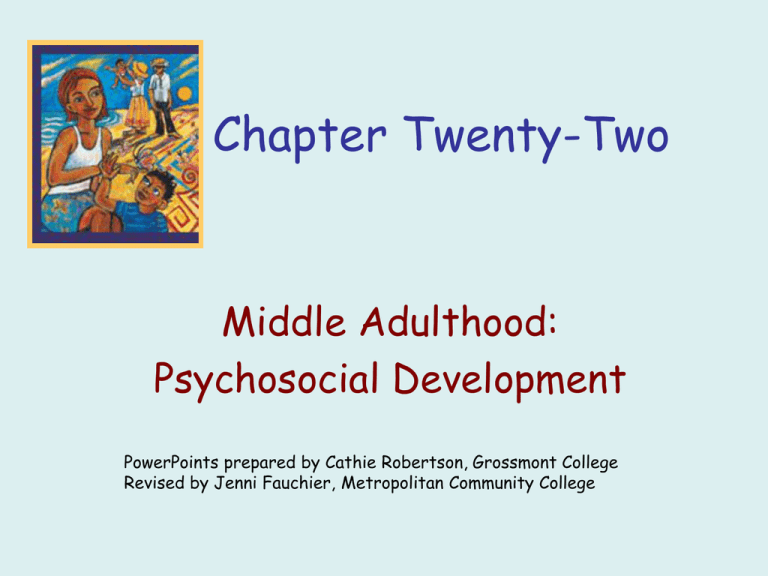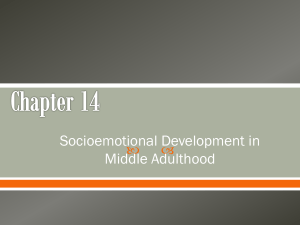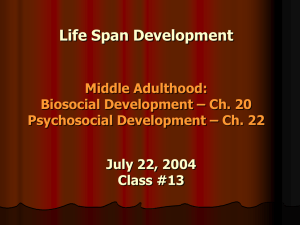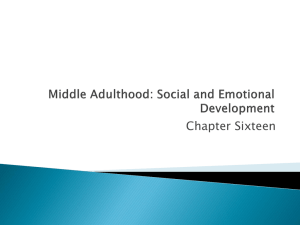Human Development - Metropolitan Community College
advertisement

Chapter Twenty-Two Middle Adulthood: Psychosocial Development PowerPoints prepared by Cathie Robertson, Grossmont College Revised by Jenni Fauchier, Metropolitan Community College Personality Throughout Adulthood • Personality is a major source of continuity – provides coherence and identity Stable Traits :The Big Five • Extroversion = outgoing, assertive, and active • Agreeableness = kind and helpful • Conscientiousness = organized, deliberate, and conforming • Neuroticism = anxious, moody, and selfpunishing • Openness = imaginative, curious, artistic, and willing to have new experiences Stable Traits :The Big Five, cont. • Traits determined by – – – – genes culture early childhood experiences and choices made during adolescence and early adulthood • Ecological niche—the specific lifestyle and social context adults settle into that are compatible with their personality needs and interests Developmental Changes in Personality • Environment generally reinforces basic temperament – significant changes can make people act differently • death of a spouse, divorce, illness, career change, etc. Gender Convergence • Gender convergence—a tendency for men and women to become more similar as they move through middle age • Gender crossover—the idea that each sex takes on the other sex’s roles and traits in later life. Gender Convergence, cont. • These ideas are partly biosocial, “shadow side,” and cultural – Barnett and Hyde (2001) believe that this change is historically-based • the past century witnessed changes every decade and gender roles changed • today’ middle-aged generation is probably less likely to converge since male-female differences in personality less apparent The “Midlife Crisis” • Midlife crisis—a period of unusual anxiety, radical reexamination, and sudden transformation widely associated with middle age, but probably more related to developmental history than to chronological age The “Midlife Crisis,” cont. • The idea was promoted by Sheehy (1976) and Levinson (1978), but no large study has found such a crisis • Why then do people talk about it as if it really existed? – myth may allow adults to cope with disappointment, frustration, sadness caused by aged-related changes Family Relationships in Midlife • Family is most important support system • If one’s own family is not doing that job, “fictive kin” may be found – treated as family by this group • Social convoy—group of people who form relationships with an individual through which they guide and socialize that person as he or she moves through life Partners • Having an intimate relationship is a source of happiness, comfort, and self-respect; for 70 percent of middle-aged Americans, this achieved with a spouse • For some divorced, widowed, or never-married middle-aged adults, intimacy may be achieved by cohabitation Marital Happiness • Not all people are in good/happy relationships – relationship may be destructive – but worldwide, spouse abuse far more common among younger married couples than among middle-aged spouses Marital Happiness, cont. • Often regain some of closeness of early marriage – less stress from kids – higher incomes – more time together • Studies in various cultures show that marital happiness in midlife is true • In general, marriage relationships likely to get better over time Divorce and Remarriage • Not all couples become closer – after years of marriage, divorce has more impact • reduces income, weakens family ties when longterms social bonds especially needed • Most divorced remarry within 5 years • Remarriage offers benefits to both men and women • Second marriages end in divorce more often than first marriages do The Marriage Market for Middle-Aged Adults • Marriage is likely to benefit middleaged adults • Middle-aged women are at a disadvantage for marrying, remarrying – beginning at aged 45, there are more women than men – men tend to marry younger women Other Relatives • Kinkeeper—the person who takes primary responsibility for celebrating family achievements, gathering the family together, and keeping in touch with family members who live far away – most likely to be middle-aged – most are women, but men also can take the role Aging Parents • Relationship with Parents – improves with time • Familism—the idea that family members support one another because family unity is more important than individual freedom and success – stronger with ethnic minorities Siblings • Siblings often become closer to each other in the second half of life than in early adulthood • They help one another with problems with teenage children, stressful marriages, and family contacts Siblings, cont. • Childhood Echoes—the relationship in middle and late adulthood is influenced by family values instilled in childhood – closeness can also be affected by childhood rivalries, but these may be put aside at this point Siblings, cont. • New Challenges—keeping up the relationship even though there are challenges such as primary caregiving of a parent by one sibling – death of a parent can increase problems—like inheritance Adult Children • Relationship with Children – improves with maturity of children • Seven-nation survey: 75 percent of middle- aged parents communicated with adult children several times a week Adult Children, cont. • Forms of Parental Support – monetary – various services like babysitting • Some children return home, referred to as “swollen nest” • Young adult children less likely to leave home, especially if parents in good health and they themselves are financially needy Grandchildren • Personality, ethnicity, national background, and past parent-child relationship affect nature of grandparent-grandchild relationship as does child’s age and personality • Bond closer if – grandchild young – parent is first to have children – grandparent neither too young nor too old to spend time/energy interacting Types of Grandparents • Remote grandparents—respected and loved – emotionally distant grandparents • Involved grandparents—active in day to day life, live near, see often • Companionate grandparents—independent, with own lifestyle and household, choose how generational interaction occurs • Most grandparents want to be companions Immigrant Grandparents • Happily become involved, especially when all speak a common language • Often live in the same household • Children seem to develop better when they are cherished and guided by a large family Immigrant Grandparents, cont. • Many immigrant and minority families do not trust the majority culture to transmit their values, beliefs, language, and customs (culture) – grandparents best source of cultural continuity Surrogate Parents • Surrogate parents—grandparents who take over the raising of their grandchildren as a result of their adult children’s extreme social problems – if parents too poor, too young, drug or alcohol addicted, single, newly divorced, then— – possibility of surrogate parenting increases Surrogate Parents, cont. • Grandparents furnish stability, guidance, and patience • Responsibility takes a toll if it lasts too long – can impair health and well-being After Adult Children Divorce • More than one in three grandparents witness divorce of an adult child • Grandparents typically provide extra help when their newly divorced child receives custody of children • If their adult child does not have custody, they may be shut out – grandparents in such situations may sue for visitation rights The Myth of the Sandwich Generation • Sandwich generation—generation of middle-aged people who are supposedly “squeezed” by the needs of the younger and older generations – Some do feel pressured, but most are not burdened by such obligations • they enjoy filling needs or— • may choose to take on some (or no) responsibilities The Myth of the Sandwich Generation, cont. • Most choose not to provide financial or caregiving help to older generation – one study shows less than 20 percent provided help of any kind – assistance 3 times more likely by African-American couples • Personality may be as influential as need in determining whether to provide substantial help to either generation Work in Middle Adulthood • 90 percent of men and 75 percent of women in the United States are employed • Worldwide, work is a welcome part of life • Most jobs provide more joy than stress Overall Trends • Meaningful work becomes more important as an individual ages – salary and benefits tend to rise with seniority – lower rates of • absenteeism • being fired or quitting • seeking a new job Overall Trends, cont. • Many middle aged workers have worked for the same employer for more than five years • There may be unexpected job loss as a result of downsizing and restructuring or relocation of company Balancing Work and Family • Unlike young men, middle-aged men are no longer more concerned with work than with their family life – parental/family role usually considered more important than work role Dealing with Job Stress • Some people addicted to long hours and hard work, or “workaholism” • Both men and women are physically and psychologically healthier if they have multiple roles • Stress in one area of life can be relieved by support from other areas Scaling Back • Begin to deliberately balance work life with other concerns – Place limits on work hours or responsibilities • One partner may work part-time or at a less critical and lower paying job • Or partners may take turns; one focuses on employment, the other on child care • Rethinking and shifting toward retirement Retirement • Planning and actual event usually occur in middle age • Retirement generally anticipated with more joy than dread • The decision to retire is usually mutual, since both husband and wife are working • Main planning consideration is financial






